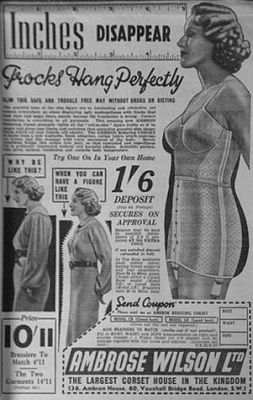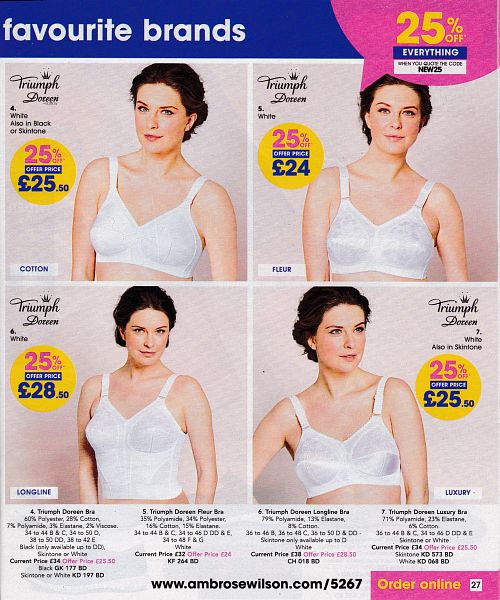
Ambrose Wilson
The company was founded in 1875 by James David Williams, who in 1882, was the first to make use of the UK's parcel post service, to send his company's products direct to his customers. The formula of providing quality, fashionable, value for money clothing direct to customers proved increasingly popular towards the latter end of the 20th Century and J D Williams enjoyed significant growth. This continuing growth has ensured J D Williams is the most successful direct home shopping company in the UK today, with over 6 million customers and 3,500 employees.
Ambrose Wilson became the trading name of J D Williams & Company Limited
1930s
|
One of AW's favourite models, and probably exactly the centre of gravity of their marketing. |
1950s
Ambrose Wilson, produced the catalogue that, more than any other, brought traditional corsetry to the British housewife for over seven decades.
Below are the corsetry pages from one of their mid-1950's catalogues. On page 3, note the amazing juxtaposition of the 'pin-up' model in the swimsuit. On the same page is a traditional back-laced, busk-front, rubber corset. Ambrose Wilson appealed to a very diverse range of tastes and ages!
Ambrose Wilson catalogue from the mid-1950's |

This just about summarises their late 1950s collection. Corsets, girdles, invisible lacing and rubber, but no panty-girdles, not yet.
|
|
The young housewife was targeted. With a good high-waisted girdle, one could wear the very shapely, and fashionable, polished cotton, polka dot dress. Even on the beach, AW would take care of you with an elastic bathing costume complete with zipper internal girdle and brassiere. There are many modern corselettes with less control than this superb garment.
|
|
|
Of course, with increasing age, or in the case of this young model, the undesirable effects of pregnancy on the waist-line, invisible lacing was yours. "Nobody need know your secret" they claimed.
|
And if that didn't work, one could always swelter away in a rubber corset and brassiere (far left - 1939; right - 1955). Alstons, the manufacturer of these garments might have had trouble selling them, but AW managed to move quite a number of these articles. The model above holds a rose to her nose. Although this is a classic corsetry pose, one can't help feel that the scent of the rose is being used as an antidote to the pungent smell of the rubber corset. |
With advancing years, the polka-dot dress is still available, and the best of British corset engineering can be provided to reduce that waist to, well, not quite what it used to be, but better than anything you are likely to see on the streets these days!
 |
 |
 |
From the Ambrose Wilson Catalogue of 1962 comes more
|
 |
|||||
  |


|
|||||
The laced-back corselette (left), makes one of its last appearances in Britain. This mainstay of the German Hausfrau would last for another two decades in Germany. The corset shop proprietor of St. Leonards once said "Women don't understand these things any more!" |
|
Personally, I hanker after the V80. Busk-front and fan-laced. There's no quicker corset to put on and adjust. My beloved Spirella 305 requires numerous hooks and eyes, and then a brief tightening of the laces. Smooth and elegant, but not rapid!
Footnote:
|
One of Ambrose Wilson's brand names for their foundations was 'Eve'. We came across this Eve corset recently and it brought back such memories. It dates from the 1950's, and was just one of many unexceptional but very functional corsets in their catalogue. Made from a 'no nonsense' beige coutil, the corset was back-laced with a busk front and a hook-and-eye'd under-belt. It was the property of an elderly lady since the back suspenders have been removed (they have been replaced on the image). Even what on other, more up-market corsets would have been elastic gores have been replaced by coutil and the laces are not flat, but circular in section. This was a post-war 'utilites only' corset (CC) and elastic was still in short supply.
Unchanged, it featured in Ambrose Wilson's catalogues right up to the end of the 1960's which is when I first remember coming across one of these study relics.
|
|
|
|
Just when you thought that the corset was a thing of the past, the Ambrose Wilson catalogue of 2011 suggests otherwise:- |
|
But sadly not in 2018, however, they do extol the virtues of the Triumph Doreen brassiere.

